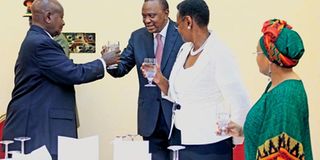How sugar barons arm-twisted state to accept imports

President Uhuru Kenyatta and Yoweri Museveni gave a directive settling on the Northern route through Kenya as the least expensive route for the Kenya-Uganda oil pipeline. The prospect of a joint crude oil pipeline between Kenya and Uganda seems to be standing on a shaky ground following a plan by a French firm to explore an alternative route. PHOTO | FILE | NATION MEDIA GROUP
What you need to know:
- The trail dates back to 2011 when Kenya allowed Uganda to import duty free sugar through Mombasa port because of the serious local shortage.
- The lords wondered why Kenya was blocking their sugar yet Uganda is Kenya’s largest trading partner; they then adjusted laws to suit their intentions and lobbied President Museveni.
In November last year, President Yoweri Museveni was in the central Uganda district of Luwero to open a chicken processing plant.
During the event, the business leaders present led by the chairman of the Yo Kuku chicken processing plant, Mr Alykhan Hudani, complained of Kenya’s restrictive behaviour towards goods from Uganda.
In his response, Mr Museveni blamed Kenyan officials who did not understand the need for faster regional integration. “Some of the Kenyan officials are narrow-minded. They are trying to block sugar, milk and now chicken. If I said no to Kenyan products here, they would not like it,” Mr Museveni said. He vowed to take up the issue with his friend, President Uhuru Kenyatta.
President Museveni’s remarks were, however, interpreted in the context of support for calls by Uganda sugar barons for Kenya to open up its market.
Just the week before the Yo Kuku remarks, Uganda Sugar Manufacturers Association had leaked to Kenyan media details of their meeting in which one of their resolutions was to fight to lift orders by Kenya blocking sugar imports from Uganda.
Led by the association chairman Jim Kabeho, the lobby group demanded explanations as to why Kenya was discriminating against Uganda.
“Sugar from other countries in SADC (Southern African Development Community) and Comesa (Common Market for Eastern and Southern Africa), which are not in the East African Community, enters Kenya with ease,” Mr Kabeho said, adding that the Ugandan sugar industry wanted answers on Kenya’s restrictive policies.
Kenya has, however, been granted protectionist measures from the Comesa trading bloc for more than a decade.
Four months before the November Kampala meeting, an East African Community ministers meeting had ordered the regulatory authorities to meet and resolve the standoff. Uganda had reported Kenya for imposing non-tariff barriers to their exports against the common market rules. The outcome did not please the sugar barons, a development that saw them turn to political lobbying.
The controversy triggered by the deal reached between Kenya and Uganda officials last week can be traced back to August 2011 when Kenya allowed Uganda to import sugar through the Port of Mombasa duty-free for a period of six months following a request by its officials to help the landlocked nation plug a deficit it was experiencing at the time.
The only condition was that the duty-free sugar would be consumed only in Uganda and if it was re-exported back to Kenya, a levy of 100 per cent would be charged like any other sugar imports.
At the expiry of the stay period in January 2012, however, Kenya tax officials observed that sugar imports from Uganda were rising steadily, which led to accusations that Ugandan sugar barons, with the possible collusion of their networks in Kenya, were circumventing the arrangement and re-exporting the sugar from other countries back to Kenya.
Kenya imposed an import ban on Ugandan sugar in October 2012 on suspicion that the manufacturers were abusing the 2011 import window and dumping duty-free sugar in Kenya.
SURPLUS
In February 2013, the Kenya Revenue Authority (KRA) stopped more than 220 tonnes of sugar from Uganda from entering the country. KRA said it was difficult to distinguish between sugar imported during the stay period and other regular imports.
Players in the Ugandan sugar industry, however, said the country’s sugar production had improved thus the surplus. Manufacturers in Uganda complained that Kenya was placing trade barriers on its sugar and going against EAC common market rules. They accused Kenya of hiding behind Comesa rules to impose a restriction on imports.
The opposition Cord and MPs from the sugar belt have expressed fears that unscrupulous traders, some of them Kenyans, could import sugar from countries like Brazil and have it repackaged in Uganda then sold as a product of that country, therefore, flooding the local market to the disadvantage of the local industry.
Kenya was first granted protectionist measures from the Comesa trading bloc in March 2002 for one year. That deal was again extended upon expiry in 2003 for another year. The second extension of four years came in March 2004, only to be extended again for another two years upon expiry in 2008. The third two-year extension expired in February 2014. The Comesa safeguards were renewed in February 2014, even as the country exhausted the maximum allowable 10 years under the World Trade Organisation remedies.
The extensions were granted by Comesa on the basis of a 2007 special amendment to the bloc’s rule that allowed safeguards for a maximum of eight years.
Sugar manufacturers in Uganda have persistently argued for the opening of Kenya’s sugar market to offload its surplus even as players in the sugar sector in Kenya have been agitating for reforms to turn around the fortunes of the sector that supports the livelihoods of around 250,000 small scale farmers.
ESCALATED
With Kenya relying on the safeguards to stop imports, Uganda sugar manufacturers escalated the matter by moving to have EAC declare their country a sugar-surplus nation, to render KRA’s attempts to stop the sugar imports an illegality.
“We cannot renege on the commitment with the EAC member states on facilitating trade across borders. What we need to do is to make production of sugar in the country competitive,” said Mr Paul Mbuni, the chairman of the Kenya Society of Agriculture Professionals.
Mr Kabeho said Uganda had informed the EAC member states that it was now a surplus producer of the commodity and, therefore, continued importation of duty-free sugar would not assist in strengthening the industry in the region.
Uganda has an installed capacity of 19,800 tonnes crushed per day (TCD). The manufacturers said the increased production was due to opening up of new mills and expansion of existing ones.
According to Uganda manufacturers, the country produces about 465,000 metric tonnes of sugar against a consumption of 320,000 metric tonnes, leaving them with a surplus of 145,000 metric tonnes.
Sugar production is projected to reach 623,700 tonnes this year. New mills in Kamuli, Kafu, Kiryadongo, Luwero and Aliak are expected to further increase the country’s production in the next two years.
In December 2014, Kenya ceded ground to Uganda’s demands, allowing them to bring in sugar with the only requirement being application of import permits, which would be issued within a week.
This was a culmination of lobbying that enlisted the support of President Museveni.
HIGH COST
Matters cooled down somewhat after assurances that Uganda exporters would be facilitated to trade across Kenyan borders without barriers as long as they acquired the required documents.
Kenya is considered the second most attractive market for sugar imports after the European Union in part due to a high cost of production that is almost double the global average of $300 (Sh30,000) per tonne.
Data from the now defunct Kenya Sugar Board puts the local production cost at $870 (Sh87,000) per tonne, way above other Comesa producers like Malawi, Zambia and Swaziland that incur a $300-350 (Sh30,000-35,000) cost per tonne. The other countries where the sugar imports come from are Zambia, Madagascar and Egypt.
Statistics from KSB last year demonstrate why regional sugar barons want to get a stranglehold on the Kenya market. Sugar in Kenya sells at an average of $2 per kilogramme, in Tanzania at $1.25 and in Uganda at $1.5 making the country attractive even to sugar imports from neighbouring countries. At the time the dollar rate against the Kenya shilling was in the Sh80s unlike now at an average of Sh100. And it’s not only in Uganda that the barons used the state to gain access. In February 2013, Zambia moved to impose duty on imports from Kenya.
Zambia’s Trade permanent secretary, Mr Stephen Mwansa, said slapping duties on Kenyan goods was in retaliation for Kenyan authorities blocking Zambian sugar manufacturers.
“There is no way we are going to allow their goods to come here while they are blocking our goods. It is trade retaliation,” he said.
At the time, 10 lorries of sugar were marooned at Namanga on the Kenya-Tanzania border for more than two weeks. Kenya was reacting to what was clearly a smuggling ring.
Between January and November 2012, Zambia’s sugar exports to Kenya had spiked by 142 per cent to 90,405 tonnes. It was the same story for Uganda which jumped 415 times from 73 tonnes in November 2011 to 30,299 tonnes in November 2012. Late last year, the government approved sugar importation, with the Sugar Directorate giving the green-light for pre-shipment by 21 firms to import 89,100 tonnes of brown/mill white.
Other countries where sugar imports were sourced from were Zambia (24,500 tonnes), Madagascar (25,000 tonnes) and Egypt (2,000).
Uganda’s push for access to the sugar market is leveraged on the need for balance of trade, which is currently in favour of Kenya.
According to the 2014 Economic Survey, Uganda was the largest destination of exports from Kenya, constituting lime, cement and fabricated construction materials (other than glass and clay).
This earned Kenya Sh65 billion in 2013, compared with Sh67 billion in 2012. On the other hand, Uganda exported goods worth Sh16 billion to Kenya in 2013. In 2014, Kenya exported goods worth Sh61 billion while Uganda exported goods worth Sh17.5 billion to Kenya. The new development comes against the backdrop of a weakened local sugar sector amid hopes that privatisation of five mills that include Chemelil, Nzoia, South Nyanza, Muhoroni and Miwani sugar companies will breathe new life.
Players in the sector say the main focus is to steer the industry from a traditional high cost single-commodity supplier to a competitive multi-product industry that is self-sufficient, a net exporter of sugar, electricity, ethanol, paper and other goods derived from cane. They say that the objective is to cut costs at farm and factory levels while setting minimum performance benchmarks in terms of crushing capacity, applicable technology and efficiency benchmarks for all mills, and mandatory diversified products which will see the local industry claim some ground in the coming years.
A cane development campaign worth Sh1.4 billion that was disbursed to millers for onward lending to farmers and pricing of sugarcane using sugar content in Bungoma and Migori counties is under way and is expected to be rolled out to all sugar zones by the end of 2016.
The government will have to navigate the issue of meeting its regional trade obligations and protecting the interests of the local farmers, a major test for policy makers.





